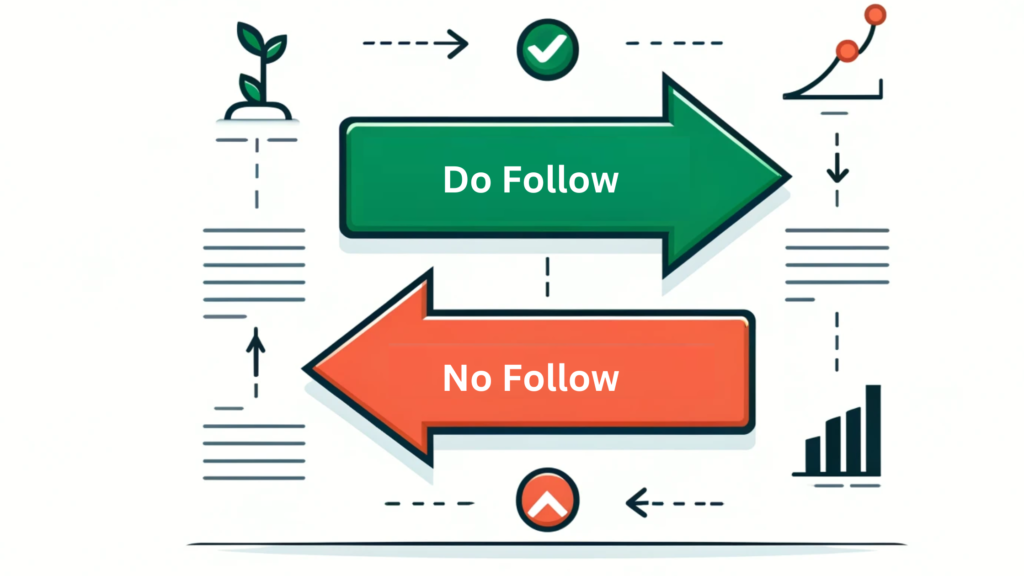Did you know that the average website has 64% do-follow links and 36% no-follow links? As an SEO consultant and founder of Mohit’s SEO Training, I’ve seen countless businesses struggle to understand the crucial difference between these two types of links. But here’s the truth: mastering the art of do-follow and no-follow links can be the key to unlocking your website’s true potential and skyrocketing your search rankings.
If you’re a small business owner, pouring your heart and soul into your online presence, you’re creating valuable content, optimizing your website, and eagerly waiting for those coveted top spots on Google’s search results. But something’s missing. Your traffic isn’t growing, and your rankings are stagnant. That’s where understanding the power of dofollow and nofollow links comes into play.
Also Read: Google’s March Core Algorithm Update
In this comprehensive guide, we’ll dive deep into the world of do-follow and no-follow links, unraveling their mysteries and showing you how to leverage them for SEO success. Whether you’re a beginner just starting your SEO journey or a seasoned marketer looking to refine your strategies, this post will provide you with actionable insights and practical tips to help you navigate the complex landscape of link building.
What Are Backlinks?
Backlinks, also known as inbound links or incoming links, are links from one website to a page on another website. They are essentially a vote of confidence from one site to another, signaling to search engines that the linked content is valuable and relevant. Backlinks play a crucial role in SEO, as they are one of the main factors that search engines like Google use to determine a website’s authority and ranking.
Also Read: Crawling in SEO
What Are Dofollow and Nofollow Links?
First, let’s talk about the superhero of the SEO world: the dofollow link. When a website links to your content using a dofollow link, it’s essentially giving search engines a powerful signal, saying, “This content is valuable, and I vouch for its quality!” This virtual endorsement helps pass along link equity (or “link juice”) from the linking page to your page, boosting your website’s credibility and authority in the eyes of search engines.
Think of it like a recommendation from a trusted friend. If a well-respected food blogger in Mumbai raves about your restaurant’s delectable panipuri, their endorsement carries weight. It can lead to more customers, more buzz, and ultimately, more success for your business. Similarly, when high-quality websites link to your content with dofollow links, it signals to search engines that your site is a trusted authority in your niche.
Also Read: Google’s March Core Algorithm Update
The Nofollow Link: The Unsung Hero
Now, let’s explore the often misunderstood no-follow link. When a website links to your content with a no-follow link, it includes a special attribute (rel=”nofollow”) that tells search engines, “I’m linking to this content, but I don’t necessarily endorse it or want to pass any link equity.”
Also Read: SEO Interview Questions
At first glance, nofollow links might seem like the less desirable option. After all, they don’t directly boost your search rankings like dofollow links do. However, nofollow links play a crucial role in creating a natural, diverse link profile – something that search engines value highly.

Imagine you’re a tech blogger reviewing the latest smartphones. You might link to a manufacturer’s website using a nofollow link to provide additional information without explicitly endorsing the product. This helps maintain transparency and adheres to search engine guidelines, especially if you’re participating in affiliate marketing or sponsored content.
Also Read: SEO Scope of Work
Moreover, nofollow links can still drive valuable referral traffic to your website. Even if they don’t directly impact your search rankings, they can expose your content to new audiences and potentially lead to future dofollow link opportunities.
Differentiating Between Nofollow And Dofollow Links in SEO
Understanding the difference between nofollow and dofollow links is crucial for effective SEO:
- Dofollow links directly contribute to your website’s link equity and can positively impact your search rankings.
- Nofollow links, while not directly boosting your rankings, help create a more natural and diverse link profile, which is valued by search engines.
Having a mix of both dofollow and nofollow links from various sources is essential for a healthy, organic link profile.
Also Read: Periodic Table in SEO
Nofollow vs. Noreferrer

Nofollow and noreferrer are both link attributes, but they serve different purposes:
- Nofollow (rel=“nofollow”): This attribute instructs search engines not to pass link equity from the linking page to the linked page.
- Noreferrer (rel=“noreferrer”): This attribute prevents the browser from sending the referring page’s URL to the linked page, enhancing privacy and security.
Also Read: What Does the Term Sandbox Mean in SEO
How to Gain Backlinks
To gain high-quality backlinks, consider the following strategies:
- Create link-worthy content: Produce exceptional content that offers genuine value to your target audience, making other websites naturally want to link to it.
- Engage in guest blogging: Contribute high-quality guest posts to reputable websites in your niche, including a dofollow link back to your site.
- Participate in broken link building: Find broken links on relevant websites and offer your content as a replacement, potentially earning a dofollow link.
- Leverage social media: Share your content on social media platforms to increase visibility and encourage others to link to your site.
- Build relationships: Network with influencers and other websites in your industry, fostering genuine relationships that may lead to natural link-building opportunities.
Also Read: Gamification in Marketing
How to Check Dofollow And Nofollow Backlinks?
You can use various SEO tools to analyze your website’s backlink profile and identify dofollow and nofollow links:
- Google Search Console: This free tool from Google provides insights into your website’s backlinks, including the linking pages and whether the links are dofollow or nofollow.
- Ahrefs: This comprehensive SEO tool offers a detailed breakdown of your backlink profile, allowing you to easily identify dofollow and nofollow links.
- SEMrush: Another popular SEO tool that provides backlink analysis, helping you understand your link profile and spot any potential issues.
Should We Target Nofollow Links?
While dofollow links are the primary target for SEO, nofollow links still offer value and should not be ignored:
- Nofollow links contribute to a natural, diverse link profile, which is important for SEO.
- They can drive valuable referral traffic to your website, exposing your content to new audiences.
- Nofollow links from high-quality, relevant websites can still boost your brand’s credibility and authority.
Do Nofollow Links Help SEO?
Although nofollow links don’t directly impact search rankings, they indirectly help SEO by:
Also Read: Exit Rate in Digital Marketing
- Creating a more natural link profile: A diverse mix of dofollow and nofollow links signals authenticity and organic growth to search engines.
- Driving referral traffic: Nofollow links can still bring valuable traffic to your site, potentially leading to increased engagement and future dofollow link opportunities.
- Boosting brand exposure: Nofollow links from reputable sources can help increase your brand’s visibility and credibility within your industry.
The Power of Strategic Link Building
At Mohit’s SEO Training, we’ve witnessed firsthand the transformative power of strategic link building. By understanding the intricacies of dofollow and nofollow links and implementing the strategies outlined in this guide, our clients have achieved remarkable results. From soaring search rankings to increased organic traffic and conversions, the impact of a well-executed link building campaign cannot be overstated.
If you want to learn SEO, we’ve got you. But don’t just take our word for it. Neetu Ghodke, a student from our previous batch, shares her success story: “I had an excellent experience with Mohit Sir during my SEO training. His teaching style simplifies complex concepts, making the classes both informative and enjoyable.
Mohit’s approach is cool and patient; he ensures that everyone understands by explaining topics multiple times. Joining his SEO training was a truly rewarding decision. Additionally, his flexibility with time adds convenience while maintaining a serious and focused class environment. Highly recommended!
FAQs
What is the ratio of dofollow and nofollow links?
Well, there is no standard answer to this question. But, the healthy ratio of do follow to no follow is 70:30.
What is the purpose of a no follow link?
Purpose of no follow link is to get some relevant referral traffic on the website. They do not contribute in boosting the authority of a website.
What is a do follow back link?
Do follow link is the link that tells the search engine crawlers to follow the page and pass the link equity to the linked page through an anchor text.
Do no follow backlinks help SEO?
Yes, no follow links do not pass the link equity to the linked page. But it gives link profile a natural link, which makes the link profile look less spammy to search engines.
Mohit Verma
I am an experienced professional with 9+ years of experience in Search Engine Optimization. I am on a mission to provide industry focused job oriented SEO so the students/mentees can get their dream SEO job and and start working from day 1.

2 thoughts on “Difference Between Do-follow and No-follow Links”
I appreciate your creativity and the effort you put into every post. Keep up the great work!
Thanks a lot Kobe.